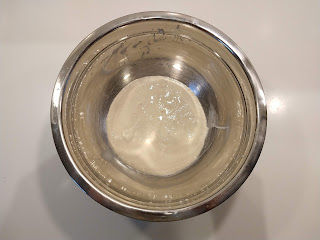 |
| 60% hydration |
 |
| 60% hydration crumb |
For a while I've had a
standard sourdough recipe that's been pretty reliable that I can bake with a flexible schedule without having to think about it too much. With the flour availability issues of late, and having more time to bake, I bought a sixteen kilogram bag of
Finest Bakers White No.1 Flour from the renown
Shipton Mill. I thought I'd try out the flour with my trusted recipe which has a hydration of about 65%, so nothing too crazy. The results were disappointing, the dough turning out much slacker, more extensible with less strength, and hence harder to shape, and the final loaf was a bit flat. The dough also seemed to ferment much faster than usual but temperatures were unusually high (the ambient temperature was around 20 degrees Celsius during the levain build).
 |
| 65% hydration, boule on the right is a bit flat |
It felt like the dough was generally a bit too wet, which I found surprising, but I thought I'd try reducing the hydration as low as 60% to see what happened. The results were interesting and I was much happier with them than the original recipe. Here's the amended recipe:
Ingredients
Makes two large loaves.
10% pre-fermented flour
| | Ingredient | Weight (g) | Baker's percentage |
Levain build
| 100% hydration rye starter | 200 | 66% |
| | Strong white flour | 300 | 100% |
| | Cold tap water | 300 | 100% |
| Final dough | Strong white flour | 700 | |
| | Tap water 30°C | 250 | |
| | Salt | 17 | |
| | Levain | 800 | |
| Overall formula | Strong white bread flour | 1000 | 90% |
| | Whole rye flour (from starter) | 100 | 10% |
| | Water | 650 | 60% |
| | Salt | 17 | 1.5% |
Method
- To build the levain, in a large bowl, mix together the starter, flour and water until evenly incorporated
- Cover the bowl and leave to rest for around eight and a half hours at about 22°C
- Add the fresh flour, water and salt to the levain build and mix together till there are no pockets of dry flour
- Knead until the dough is smooth and elastic
- Form into a ball, return the dough to its lightly-floured bowl and cover
- Leave to prove for 45 minutes at 25°C
- Letter-fold the dough, return it to the bowl and cover it
- Leave to prove for another 45 minutes at 25°C
- Turn the dough out onto a lightly-floured work-surface and divide it in two
- Pre-shape the two portions of dough into balls and leave to rest on the bench (covered) for around 15 minutes
- Shape the loaves as batards using the cinching method
- Leave them to prove in oval bannetons for an hour and a half at 23°C
- Cut them with a razor blade, on a slight curve to one side of the loaf, and bake them on a stone in a fan-oven pre-heated to 250°C with some boiling water on tray at the bottom of the oven
- After loading the loaves into the oven, lower the temperature to 220°C to prevent scorching
- After 10 minutes remove the water-tray and rotate the loaves in the oven to given an even colour
- Bake them for a further 15 minutes, remove them from the oven and leave them to cool on a wire rack
Things to note
I've never had this sourdough recipe prove so rapidly, I think it must be a combination of the flour the warm weather and my starter that made it behave that way. Also I was surprised that such dry dough yielded good results, but don't expect the same to hold true for you as every flour is different. The biggest lesson for me was that you can't just follow the timings or even ratios for a known recipe, something as simple as changing flour brand can make a big difference. I wouldn't have ended up at this point without methodically working through a couple of failed attempts at higher hydrations.
N.B. if you want more detail on the techniques involved in the method, they're more fully described in the original
standard sourdough recipe





















